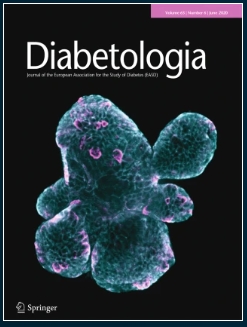I-BET151 modulates glucokinase gene expression and beta cell function in part through changes in FOXO1 expression.
IF 10.2
1区 医学
Q1 ENDOCRINOLOGY & METABOLISM
引用次数: 0
Abstract
AIMS/HYPOTHESIS The bromodomain and extra-terminal (BET) protein family acts as 'epigenetic readers' to identify the acetylation marks on histones that convert the acetylated lysine residues into observable phenotypes. BET proteins have gained attention due to their ability to modulate the transcription of pathology-related genes involved in cancer and autoimmune diseases, including type 1 diabetes mellitus. However, targeting BET proteins may have secondary effects on other host cells. We aimed to elucidate possible secondary effects of BET inhibition on pancreatic beta cell function. METHODS We studied the effect of the small-molecule BET inhibitor I-BET151 on pancreatic beta cells in vitro, ex vivo and in vivo. GTTs, ITTs and glucose-stimulated insulin secretion assays were performed in healthy mice and a mouse model of diabetes following daily i.p. injections of I-BET151 for 2 weeks. Transcriptomic analysis was carried out on primary mouse islets, which were subjected to ex vivo I-BET151 treatment. Changes in expression were further validated in primary human islets. RESULTS Administration of I-BET151 modestly but significantly increased glucose excursions and reduced insulin responses in both healthy mice and diabetic mice. We found that I-BET151 exposure significantly reduced the expression of Hnf4α (also known as Hnf4a; MODY1), Gck (MODY2), Hnf1α (also known as Hnf1a; MODY3), Glut2 and other genes essential for beta cell function in rat INS-1E insulinoma cells and in mouse primary islets and human islets. Global gene expression analysis in cells treated with I-BET151 showed a downregulation of the phosphoinositide-3-kinase (PI3K)-Akt pathway. Downregulation of forkhead box protein O1, a downstream transcriptional factor of the PI3K-Akt pathway, partially rescued I-BET151-driven downregulation of Gck and insulin secretion. Likewise, islets from I-BET151-treated mice showed a modest reduction in glucose-stimulated insulin secretion. CONCLUSIONS/INTERPRETATION The results presented here suggest that BET inhibition therapy should be used with caution due to possible bimodal effects at high concentrations at the detriment of pancreatic beta cell function.I-BET151部分通过改变FOXO1表达调节葡萄糖激酶基因表达和β细胞功能。
目的/假设溴域和外端(BET)蛋白家族作为“表观遗传读者”,识别组蛋白上的乙酰化标记,将乙酰化赖氨酸残基转化为可观察的表型。BET蛋白由于能够调节与癌症和自身免疫性疾病(包括1型糖尿病)相关的病理相关基因的转录而受到关注。然而,靶向BET蛋白可能对其他宿主细胞有继发性影响。我们的目的是阐明BET抑制对胰腺细胞功能可能的继发性影响。方法采用体外、离体和体内三种方法研究小分子β - β抑制剂I-BET151对胰腺β细胞的影响。在健康小鼠和糖尿病小鼠模型中,每天注射I-BET151 2周后,进行gtt、ITTs和葡萄糖刺激胰岛素分泌测定。对经体外I-BET151处理的小鼠原代胰岛进行转录组学分析。在原代人胰岛中进一步证实了表达的变化。结果I-BET151适度但显著地增加了健康小鼠和糖尿病小鼠的葡萄糖漂移,降低了胰岛素反应。我们发现,暴露于I-BET151显著降低了大鼠in - 1e胰岛素瘤细胞、小鼠原代胰岛和人胰岛中Hnf4α(也称为Hnf4a; MODY1)、Gck (MODY2)、Hnf1α(也称为Hnf1a; MODY3)、Glut2和其他β细胞功能必需基因的表达。在I-BET151处理的细胞中,全局基因表达分析显示PI3K -Akt通路下调。PI3K-Akt通路下游转录因子forkhead box蛋白O1的下调部分挽救了i - bet151驱动的Gck和胰岛素分泌下调。同样,i - bet151处理小鼠的胰岛显示葡萄糖刺激的胰岛素分泌适度减少。结论/解释本研究的结果表明,由于高浓度的BET抑制治疗可能会损害胰腺细胞功能的双峰效应,因此应谨慎使用。
本文章由计算机程序翻译,如有差异,请以英文原文为准。
求助全文
约1分钟内获得全文
求助全文
来源期刊

Diabetologia
医学-内分泌学与代谢
CiteScore
18.10
自引率
2.40%
发文量
193
审稿时长
1 months
期刊介绍:
Diabetologia, the authoritative journal dedicated to diabetes research, holds high visibility through society membership, libraries, and social media. As the official journal of the European Association for the Study of Diabetes, it is ranked in the top quartile of the 2019 JCR Impact Factors in the Endocrinology & Metabolism category. The journal boasts dedicated and expert editorial teams committed to supporting authors throughout the peer review process.
 求助内容:
求助内容: 应助结果提醒方式:
应助结果提醒方式:


